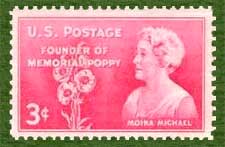









for those who have died in our nation's service.
There
are many stories as to its actual beginnings, with over two dozen cities and
towns laying claim to being the birthplace of Memorial Day.
There is also evidence
that organized women's groups in the South were decorating graves before the
end of the Civil War: a hymn published in 1867, "Kneel Where Our Loves are
Sleeping" by Nella L. Sweet carried the dedication "To The Ladies of the
South who are Decorating the Graves of the Confederate Dead" (Source: Duke
University's Historic American Sheet Music, 1850-1920).
While Waterloo
N.Y. was officially declared the birthplace of Memorial Day by President Lyndon
Johnson in May 1966, it's difficult to prove conclusively the origins of the
day. It is more likely that it had many separate beginnings. Memorial Day was
officially proclaimed on 5 May 1868 by General John Logan, national commander
of the Grand Army of the Republic, in his General Order No. 11, and was first
observed on 30 May 1868, when flowers were placed on the graves of Union and
Confederate soldiers at Arlington National Cemetery. The South refused to
acknowledge the day, honoring their dead on separate days until after World War
I (when the holiday changed from honoring just those who died fighting in the
Civil War to honoring Americans who died fighting in any war). It is now
celebrated in almost every State on the last Monday in May (passed by Congress
in 1968 to ensure a three day weekend for Federal holidays), though several
southern states have an additional, separate day for honoring the Confederate
war dead: January 19 in Texas, April 26 in Alabama, Florida, Georgia, and
Mississippi; May 10 in South Carolina; and June 3 (Jefferson Davis' birthday)
in Louisiana and Tennessee.
In 1915, inspired by
the poem "In Flanders Fields," Moina Michael replied with her own
poem:
We
cherish too, the Poppy red
That grows on fields where valor led,
It seems to signal to the skies
That blood of heroes never dies.
She then conceived of
an idea to wear red poppies on Memorial day in honor of those who died serving
the nation during war. She was the first to wear one, and sold poppies to her
friends and co-workers with the money going to benefit servicemen in need.
Later a Madam Guerin from France was visiting the United States and learned of
this new custom started by Ms. Michael and when she returned to France, made
artificial red poppies to raise money for the war orphaned children and widowed
women. This tradition spread to other countries. In 1948 the US Post Office
honored Ms Michael for her role in founding the National Poppy movement by
issuing a red 3 cent postage stamp with her likeness on it.

Since the late
50's on the Thursday before Memorial Day, the 1,200 soldiers of the 3d U.S.
Infantry place small American flags at each of the more than 260,000
gravestones at Arlington National Cemetery. They then patrol 24 hours a day
during the weekend to ensure that each flag remains standing.
And since 1998,
on the Saturday before the observed day for Memorial Day, the Boys Scouts and
Girl Scouts place a candle at each of approximately 15,300 grave sites of
soldiers buried at Fredericksburg and Spotsylvania National Military Park on Marye's
Heights (the Luminaria Program).
But most
Americans nowadays have forgotten the meaning and traditions of Memorial Day.
To help
Americans re-educate and remind Americans of the true meaning of Memorial Day,
the "National Moment of Remembrance" resolution was passed on Dec
2000 which asks that at 3 p.m. local time, for all Americans "To
voluntarily and informally observe in their own way a Moment of remembrance and
respect, pausing from whatever they are doing for a moment of silence or listening
to 'Taps."
Additionally,
on January 19, 1999 Senator Inouye introduced bill S 189 to the Senate which
proposes to restore the traditional day of observance of Memorial Day back to
May 30th instead of "the last Monday in May". On April 19, 1999
Representative Gibbons introduced the bill to the House (H.R. 1474). The bills
were referred the Committee on the Judiciary and the Committee on Government
Reform.
To date, there
have been no further developments on the bill. Please write your Representative
and your Senators, urging them to support these bills.
Sources and related links:
·
Boalsburg,
Pa., Birthplace of Memorial Day
[www.rootsweb.com/~pacentre/memory.htm]
·
DC City Pages: History of Memorial Day.
[www.cnn.com/US/9805/25/memorial.day.wrap/]
·
General
Logan Biography
[www.jal.cc.il.us/johnlogan.html]
·
General
Logan's General Order 11
[www.usmemorialday.org/order11.html]
·
Help
Restore the Traditional Day of Observance of Memorial Day
[www.usmemorialday.org/act.html]
·
Historic American Sheet Music, 1850-1920 from Duke
University).
[memory.loc.gov/ammem/award97/ncdhtml/hasmhome.html]
·
How to
Observe Memorial Day.
[www.usmemorialday.org/observe.htm]
·
Luminaria
Program
[www.nps.gov/frsp/luminari.htm]
·
The
Origins of Memorial Day
[www.va.gov/articles/celebam/memday.htm]
·
Roy, Nuhn. Portfolio: To Honor The Memory
of the Departed. American History Illustrated 1982 17[3]:
20-25.
·
S 189
and H.R. 1474, bills to restore the traditional day of
observance of Memorial Day.
[www.usmemorialday.org/act.html]
·
"S.
Con. Res. 100", resolution for a
National Moment of Remembrance.
[www.usmemorialday.org/resolution.html]
·
Statement on Signing the National Moment of Remembrance Act
[www.usmemorialday.org/speeches/president/dec2800.txt]
·
Taps
Information.
[www.usmemorialday.org/taps.html]
·
Waterloo,
Official Birthplace of Memorial Day.
[www.rootsweb.com/~nyseneca/memorial.htm]





